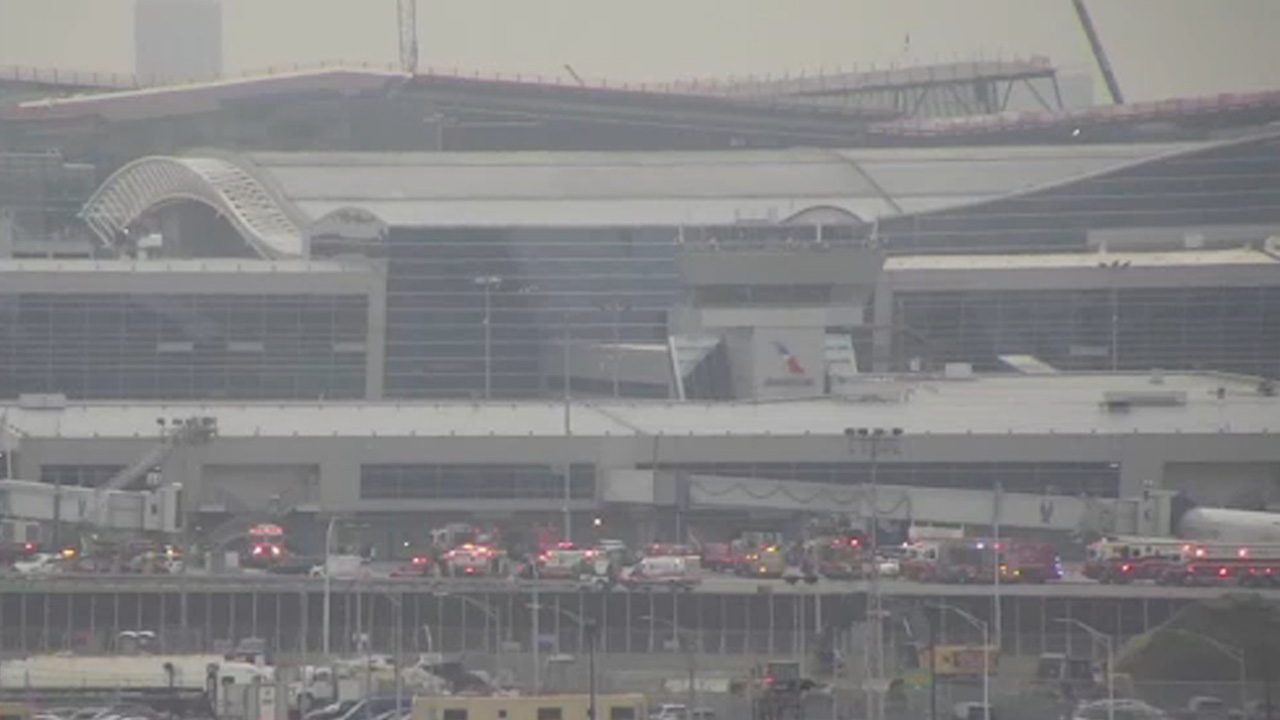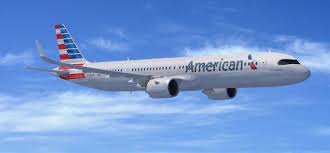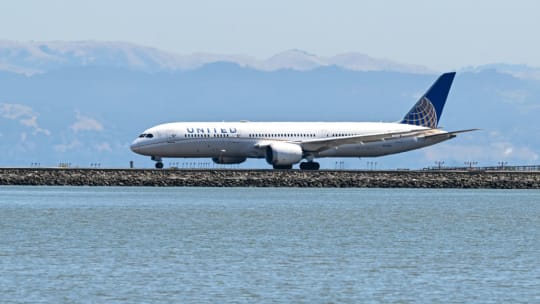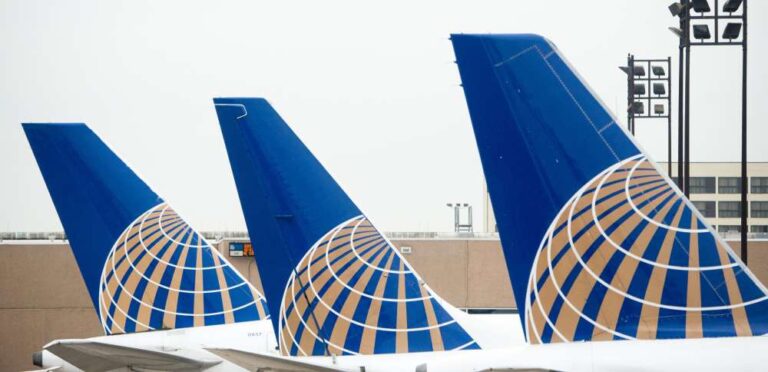9 injured, dozens of flights canceled or delayed after fire breaks out at JFK Airport in New York
100 people evacuated from JFK Airport’s Terminal 8 after escalator fire
The escalator fire created a smoke condition at JFK’s Terminal 8.
NEW YORK (WPVI) — Nine people suffered minor injuries and hundreds of flights were impacted after a small fire broke out at JFK Airport in New York on Wednesday morning.
The fire broke out on an escalator in Concourse C and spewed smoke through Terminal 8 around 7:15 a.m.
About 960 people were evacuated from the area and taken to another part of the terminal. Nine people were injured — all with minor smoke inhalation — and four were taken to the hospital to be checked out.
The FDNY has checked the entire terminal which is now being ventilated.
The terminal is occupied by American Airlines and so far 69 flights have been canceled and 332 of their flights have been delayed — which is 9% of the airline’s flights.
The airport suggests checking with your carrier before traveling.
The exact cause of the fire is under investigation.
Escalator Fire at JFK Airport’s Terminal 8: An In-Depth Report
On Wednesday morning, a small yet significant fire broke out at JFK Airport in New York, causing substantial disruption. The incident occurred on an escalator in Concourse C of Terminal 8, leading to a smoke condition that quickly spread throughout the terminal. The event resulted in the evacuation of nearly 1,000 people and impacted hundreds of flights.
The Incident Unfolds
At approximately 7:15 a.m., an escalator fire was reported in Concourse C of Terminal 8. This escalator fire generated a substantial amount of smoke, causing concern among passengers and airport staff. The fire department responded promptly, with the FDNY arriving on the scene to control the situation and ensure the safety of everyone present.
Immediate Response and Evacuation
In response to the escalating smoke condition, airport authorities decided to evacuate the affected areas. Approximately 960 individuals were evacuated from Terminal 8 and relocated to a different section of the terminal. This evacuation was carried out swiftly to minimize exposure to smoke and potential harm.
Nine individuals suffered minor injuries due to smoke inhalation. Among them, four were taken to a nearby hospital for further medical evaluation. Thankfully, there were no severe injuries reported, and the prompt medical attention ensured that all affected individuals received the necessary care.
Impact on Flight Operations
The fire and subsequent evacuation had a significant impact on flight operations at JFK Airport, particularly for American Airlines, which occupies Terminal 8. As a result of the incident, 69 flights were canceled, and an additional 332 flights were delayed. This accounted for approximately 9% of American Airlines’ scheduled flights for the day.
Passengers scheduled to travel through Terminal 8 faced considerable disruptions, with many experiencing long delays or cancellations. The airport advised travelers to check with their respective airlines for the latest updates on their flight status before heading to the airport.
Ensuring Safety and Restoring Operations
The FDNY conducted a thorough inspection of Terminal 8 to ensure that the fire was completely extinguished and that no further risks were present. Following the inspection, efforts were made to ventilate the terminal and clear the remaining smoke. This process was crucial in making the terminal safe for passengers and staff to return.
Airport authorities and American Airlines worked closely to restore normal operations as quickly as possible. Given the extent of the disruption, this was a challenging task, but the cooperation between various teams facilitated a smoother recovery.
Investigation into the Cause
The exact cause of the escalator fire remains under investigation. Determining the cause is essential not only for understanding the specific incident but also for preventing similar occurrences in the future. The investigation will likely involve examining the escalator’s mechanical systems, maintenance records, and any other relevant factors that could have contributed to the fire.
Passenger Experiences
Passengers who were at Terminal 8 during the incident described the situation as chaotic but were generally appreciative of the swift response from airport staff and emergency services. Many passengers shared their experiences on social media, highlighting the confusion and anxiety caused by the sudden evacuation but also noting the professionalism and efficiency of the responders.
Broader Implications for Airport Safety
This incident underscores the importance of stringent safety protocols and regular maintenance checks in airport operations. Escalators, like all mechanical systems in busy public spaces, require frequent inspections and upkeep to ensure they operate safely and efficiently. The fire at JFK serves as a reminder of the potential risks associated with even routine equipment and the need for continuous vigilance.
American Airlines’ Response
American Airlines, the primary occupant of Terminal 8, issued a statement expressing gratitude for the quick action of the FDNY and airport staff. The airline also apologized to passengers for the inconvenience caused and assured them that they were working to minimize disruptions and accommodate affected travelers.
American Airlines has a robust contingency plan for such emergencies, which includes rebooking passengers on alternate flights and providing support for those needing accommodations due to delays. The airline emphasized its commitment to passenger safety and its efforts to resume normal operations swiftly.
Lessons Learned and Future Precautions
In the aftermath of the fire, JFK Airport and American Airlines are likely to review their emergency response procedures and maintenance schedules. This review will aim to identify any areas for improvement and implement measures to enhance safety and efficiency. Ensuring that all equipment, particularly critical infrastructure like escalators, is in optimal condition is paramount.
Regular drills and training for airport staff and emergency responders are also essential. These drills help prepare personnel for a range of scenarios, ensuring that they can act quickly and effectively in real emergencies.
Conclusion
The escalator fire at JFK Airport’s Terminal 8 was a significant incident that caused substantial disruption but, fortunately, resulted in only minor injuries. The prompt response from the FDNY, airport authorities, and American Airlines helped mitigate the impact and ensured passenger safety. As investigations continue to determine the cause of the fire, this incident serves as a crucial reminder of the importance of regular maintenance and robust emergency protocols in keeping airports safe and operational.
Passengers affected by the incident are encouraged to stay in touch with their airlines for updates and support. Meanwhile, the broader aviation community will undoubtedly take note of this event and the lessons it offers for improving safety and preparedness in the future.
A Closer Look at the Evacuation Process
Evacuating nearly 1,000 individuals from Terminal 8 was no small feat. The airport’s emergency response team executed the evacuation with precision and efficiency, ensuring that passengers were moved to a safer part of the terminal without causing panic or chaos. This swift action likely prevented more serious injuries and highlighted the importance of regular emergency drills and preparedness in such high-traffic environments.
Coordination with Emergency Services
The coordination between JFK Airport staff and the FDNY was a critical aspect of managing this crisis. Upon arrival, the FDNY immediately assessed the situation, prioritized the evacuation of the affected area, and began firefighting efforts. The seamless communication and cooperation between these entities played a vital role in mitigating the potential risks posed by the fire.
The airport’s emergency protocols were put to the test, and the successful evacuation is a testament to the rigorous training and preparedness of both the airport staff and emergency responders. Regular joint drills between airport authorities and local emergency services are essential in maintaining this level of readiness.
Passenger Assistance and Welfare
In the wake of the evacuation, ensuring the welfare of the evacuated passengers became a top priority. Airport staff and American Airlines personnel worked tirelessly to provide information, support, and necessary accommodations to those affected. Passengers were given updates on their flight statuses, assistance with rebooking, and access to amenities while they waited for further instructions.
For those with injuries, medical personnel were on hand to provide immediate care. The swift transportation of four individuals to the hospital for further evaluation underscores the responsiveness and dedication of the on-site medical teams. Ensuring that all passengers received the care and support they needed was a crucial aspect of the airport’s emergency response.
Flight Disruptions and Passenger Impact
The ripple effect of the fire on flight schedules was significant. With 69 flights canceled and 332 delayed, the impact was felt not only by those at JFK but also by passengers at connecting airports worldwide. The cancellations and delays affected thousands of travelers, many of whom faced long waits and uncertainty regarding their travel plans.
Communication with Passengers
Effective communication was vital in managing passenger expectations and providing timely updates. American Airlines utilized various channels, including social media, email, and airport announcements, to keep passengers informed. The airline’s customer service teams were also on high alert, assisting passengers with rebooking and providing guidance on alternative travel arrangements.
Rebooking and Accommodations
For passengers whose flights were canceled, American Airlines offered rebooking options on the next available flights. The airline also provided accommodations for those who had to stay overnight due to the disruptions. While the situation was far from ideal, the efforts to accommodate affected passengers helped mitigate some of the frustration and inconvenience caused by the incident.
Impact on Airline Operations
The logistical challenges posed by the fire and subsequent flight disruptions were immense. American Airlines had to reallocate resources, including aircraft and crew, to manage the altered schedules. This required meticulous planning and coordination to minimize further delays and ensure the continuation of operations.
Long-Term Implications for Airport Safety
The fire at JFK Airport’s Terminal 8 will undoubtedly prompt a thorough review of safety protocols and maintenance procedures. Both JFK Airport and American Airlines are expected to conduct comprehensive investigations to identify the root cause of the fire and implement measures to prevent a recurrence.
Maintenance and Inspection Protocols
One of the primary areas of focus will be the maintenance and inspection protocols for escalators and other critical infrastructure. Ensuring that all mechanical systems are regularly inspected and maintained is crucial in preventing similar incidents. Enhanced maintenance schedules, more rigorous inspections, and the use of advanced monitoring technology could all play a role in improving safety.
Emergency Preparedness and Training
The incident also highlights the importance of continuous training and preparedness for emergency situations. Regular drills that simulate various scenarios, including fires, evacuations, and other emergencies, help ensure that staff and responders are always ready to act swiftly and effectively.
Passenger Perspectives and Experiences
Hearing from the passengers who were present during the incident provides valuable insights into the human impact of such events. Many passengers described a sense of initial confusion and anxiety as the smoke began to fill the terminal. However, the clear and calm instructions from airport staff helped to quickly alleviate panic and facilitate an orderly evacuation.
Social Media Reactions
In the age of social media, many passengers took to platforms like Twitter and Facebook to share their experiences in real time. These posts ranged from expressions of frustration over flight delays to gratitude for the prompt response from emergency services. Social media also served as a critical tool for disseminating information and updates, allowing passengers to stay informed and connected.
Future Enhancements and Innovations
Looking forward, the aviation industry is likely to explore new technologies and innovations to enhance safety and emergency response. This could include advanced fire detection and suppression systems, improved communication tools for real-time updates, and the integration of artificial intelligence to monitor and predict potential equipment failures.
Technological Innovations
Emerging technologies like IoT (Internet of Things) devices can provide real-time data on the status of escalators and other mechanical systems, allowing for predictive maintenance and early detection of potential issues. AI-powered analytics can help identify patterns and trends that could indicate an increased risk of equipment failure, enabling preemptive action.
Enhanced Emergency Protocols
Airports may also consider revising and enhancing their emergency protocols based on the lessons learned from this incident. This could involve more frequent and comprehensive drills, better coordination with local emergency services, and improved communication strategies to keep passengers informed during emergencies.
The escalator fire at JFK Airport’s Terminal 8 was a significant event that disrupted operations and impacted many passengers. However, the prompt and effective response from the FDNY, airport staff, and American Airlines helped to mitigate the potential risks and ensure the safety of those present. As the investigation into the cause of the fire continues, this incident serves as a critical reminder of the importance of maintenance, preparedness, and effective communication in managing emergencies in high-traffic environments like airports.
Moving forward, the aviation industry can take valuable lessons from this incident to enhance safety protocols, improve emergency response, and integrate new technologies to prevent similar occurrences in the future. While the disruptions were significant, the resilience and coordination demonstrated by all involved highlight the strengths of the current systems and the potential for continued improvement.






